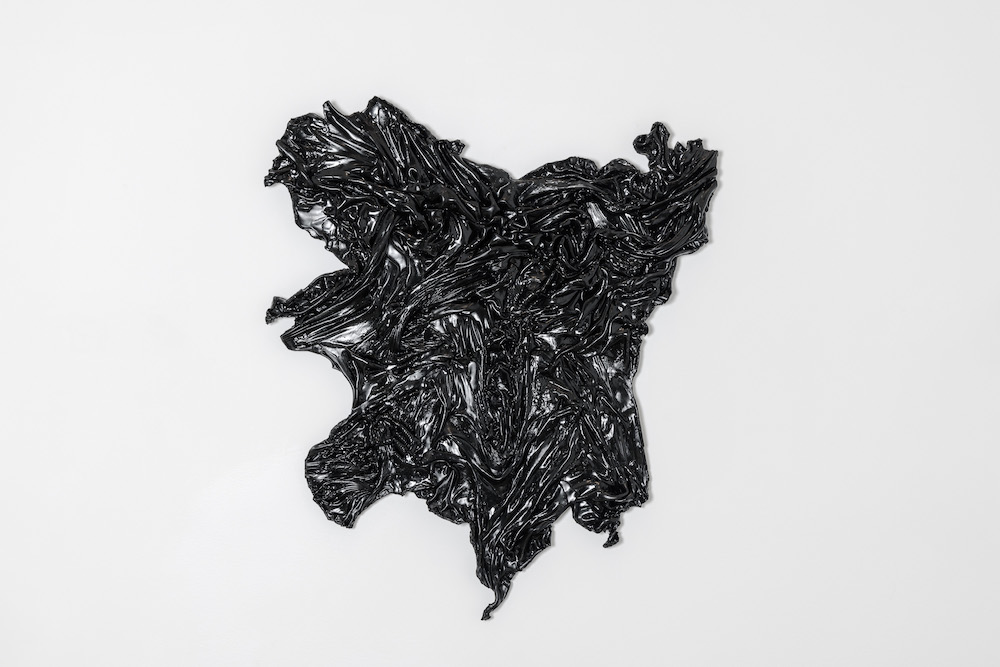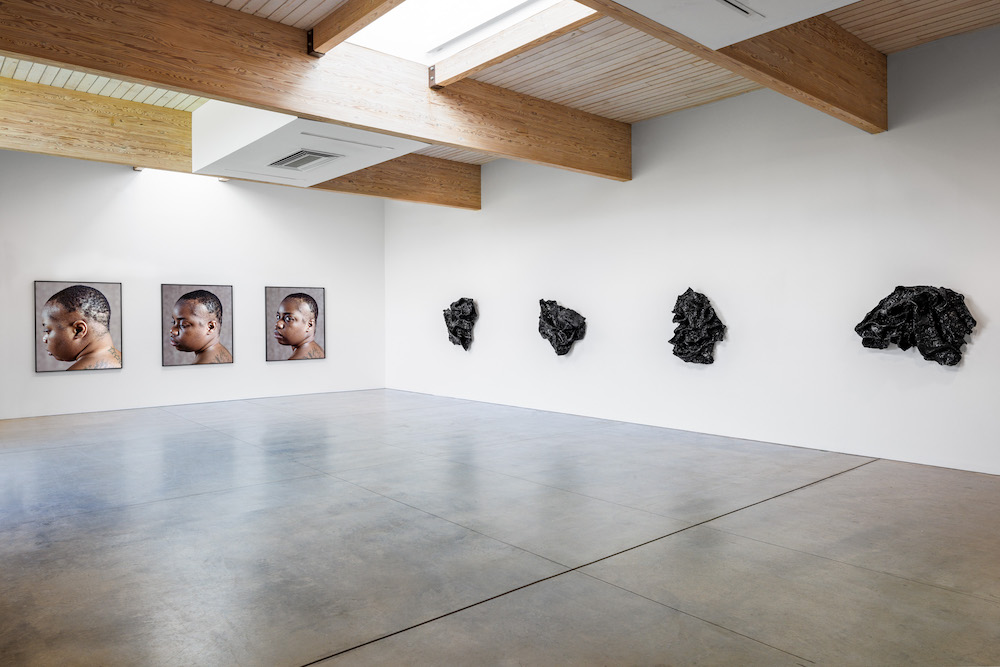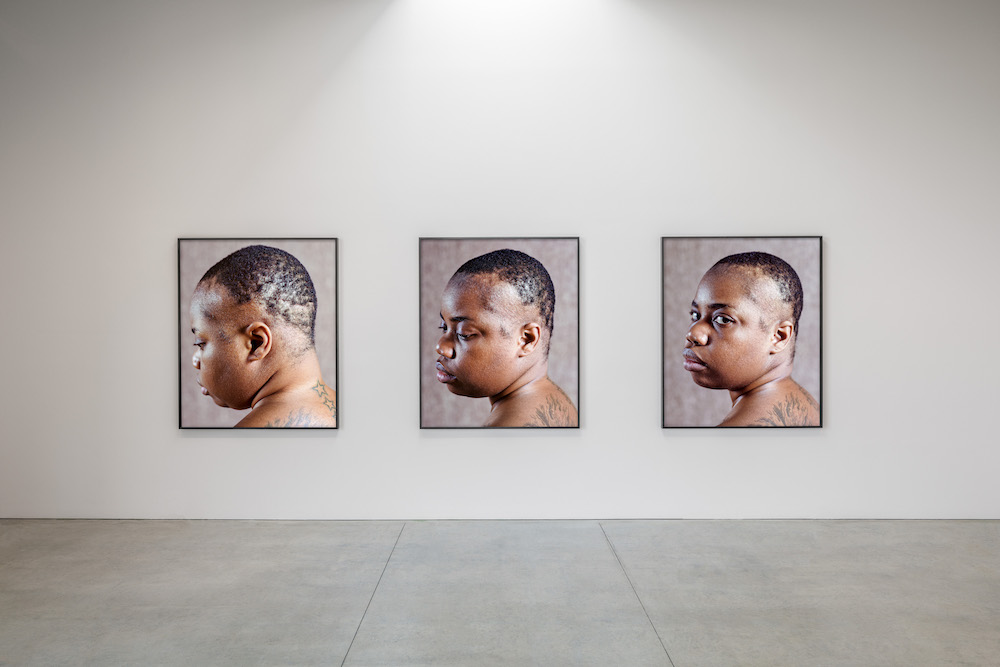I’m often asked which artist or artists interest me the most, or some variation of the question. For the last year-and-a-half since I saw her work in “Un/Common Proximity,” a group show at James Cohan in New York, my response has been Allana Clarke. Before this show, the Trinidadian-American artist had already made a name for herself with videos, performance, photography and text-based works that explore aspects of embodied Blackness and abstraction. In “Un/Common Proximity,” Clarke exhibited work from her residency with NXTHVN, the Connecticut-based fellowship. Along with her cohort, Clarke considered the idea of proximity, geographic and ideological, and how the pandemic disrupted and altered this notion.
As part of her practice, Clarke makes cocoa-butter wall sculptures with short poems or individual words. Some are inspired by her Caribbean heritage and many contend with the experience of being Black in a society dominated by white norms. So does the material itself. As both an ingredient in balms and one inextricably tied to slavery and child labor on cocoa farms, cocoa butter is layered with significance. In the group show, one of these pieces contained the word “relentless,” a reflection of the resilience of humanity in the face of a pandemic.
Joining this work was something new for Clarke: a large, black sculpture made of hair bonding glue hanging on the wall in a heavy, undulating bundle of folds—as if a giant hand had crumpled a thick, rubbery blanket. Hair bonding glue is commonly used by Black women to adhere hair extensions to the scalp to conform to white and European standards of beauty and contend with the politicization of Black hair.

Allana Clarke, Aftermaths, 2021. Salon Pro 30 Second Super Hair Bond Glue (Rubber latex and black carbon dye). 43 x 34 x 3 in (109.22 x 86.36 x 7.62 cm). Collection of Dr. Charles Boyd. Photo: Alon Koppel. Courtesy of the artist and Kavi Gupta, Chicago.
“This is often a ritual passed down from matriarch to daughter,” says Clarke over email. “It was passed down to me starting at age 13. A ritual of chemical hair straighteners and extensions.” The processes were never questioned despite the damage that continual use of the material has on hair follicles. “Adopting European idealizations of beauty signified an overcoming of the radical and political nature of Black hair in its natural state and an alignment with European standards of respectability and social mobility,” she says, adding that society still contends with discriminatory practices against Black hair. “I think about the 2016 SCOTUS ruling that it’s acceptable to deny employment to or fire someone who has dreadlocks, a common hairstyle with historical and cultural significance for those in the African Diaspora,” she says, also referencing the CROWN Act (Creating a Respectful and Open World for Natural Hair), the 2019 California law that prohibits race-based hair discrimination in employment and educational opportunities, which only 18 states have adopted.
Clarke considers these larger meanings of hair bonding glue and pushes the boundaries of the material. In October, she opened her first solo institutional show, “A Particular Fantasy,” at Art Omi and Bennington College’s Usdan Gallery. Across both venues, the exhibition highlighted the role of Clarke’s body in her practice. “The works oscillate between conceptions of desirability, the complexity of my articulation as a subject and a presence intertwined with shame, violence and generational trauma, but moving through to a space governed by Black feminist futurity,” she says. The exhibition title was taken from Audre Lorde’s Eye to Eye: Black Women, Anger, and Hatred. The excerpt addresses Lorde’s upbringing and how notions of self are passed down by matriarchs, a topic Clarke says she also relates to.
Included at the Bennington location was a performance film that documented Clarke as she created a 25-foot-long hair-bonding glue sculpture as part of a three-week residency on site. Made in collaboration with filmmaker Corinne Spencer and assistance from Rafaella Binder-Gavito, Vic Coronel, Juan Lopez and Jenna Taus (all Bennington College students), the film shows Clarke’s highly laborious, performative process.
She approaches the material with an open mind to fully explore how it works. She first pours glue from the small bottles in which they are sold onto a mesh surface, creating thick layers that slowly form a leathery top as they dry. This pliable layer becomes Clarke’s canvas as she twists, pulls and rips the surface with her hands and feet. The resulting heavy, textured surfaces reveal every move of Clarke’s body, linking the two definitively.

Installation view: Allana Clarke: A Particular Fantasy, 2022. Art Omi, Ghent, New York. Photo: Alon Koppel. Courtesy of the artist.
Through this process, Clarke strips the material of its intended function. The glue no longer represents the ritual of conforming to European beauty ideals. Instead, “a new ritual emerges oriented towards resurrection, healing and freeing,” Clarke says. “The material is defamiliarized and allowed to function in a far more expansive way than it previously could. Bringing this material into the studio is a way to contend with its complexities and reorient something that I have such traumatic associations with.”
No one sculpture is like another, a fact made clear in A Particular Fantasy. Some are tight bundles of thick, folded drapes. Others are relatively flat with pinched folds across the surface, sometimes resembling maps with their pulled borders stretched like the
edges of a coast. It’s impossible not to think of the artist working with the material, “like wrestling with a body” as she describes it.
Clarke’s reference to wrestling a body underscores one of the most intriguing parts of her work. The sculptures are physical evidence of her body’s labor. Every step of their creation was the result of her actions. There are very few occasions, however, where the sculptures themselves resemble bodies. In those moments when they do, when the body of the artist and the body of the sculpture collide, something beautiful and powerful occurs. For the 2022 edition of FRONT International: Cleveland Triennial for Contemporary Art, Clarke made At a Depth Beyond Anyone (2022), a large sculpture installed at the Akron Art Museum. The right side of the sculpture resembles the tight bundles of folds expected of Clarke’s work, but on the left, the heavy surface unfolds onto the ground. Within this left side, the outline of a figure appears. The figure seems to be pulling away from the folds, its act of breaking free frozen in time. Perhaps this is the perfect embodiment of liberation that Clarke sought to achieve. Standing up against the weight of the thick surface, the unseen figure triumphs against the burden of its own material and a new ritual emerges.


